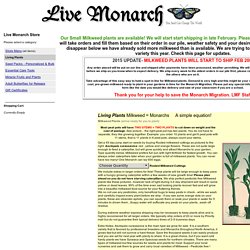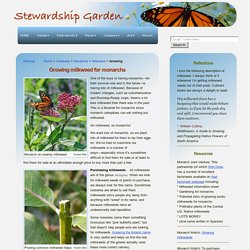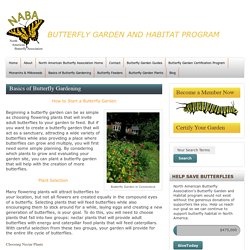

Live monarch butterfly you can raise and release Free milkweed seeds. We include extras in larger orders for free!

These plants will be large enough to keep pace with a hungry growing caterpillar within a few weeks of new growth time! Please plan ahead so you do not have starving caterpillars. We ship perfect pesticide free Milkweed plants like these pictured...however lack of light during 3-4 day shipment will result in some yellow or dead leaves. 99% of the time even sad looking plants recover fast and will grow into a beautiful milkweed food source for your fluttering friends. We no not use any pesticides, only beneficial bugs to keep pests in check - while we wash and carefully inspect every plant before we ship - if you see some orange dots on your plants, these are oleander aphids, you can squish them or soak your plants in water for 5 minutes to drown them...Soapy water will suffocate any pests on your plants...wash off residue. Extra Notes: Asclepais curassavica is the main type we grow for sale.
Growing Milkweed for Monarch Butterflies. Our Habitat Garden. ©Janet AllenMonarch on swamp milkweed One of the keys to having monarchs—for their survival now and in the future—is having lots of milkweed.

Because of modern changes, such as suburbanization and Roundup-Ready crops, there's a lot less milkweed than there was in the past. This is a disaster for monarchs since monarch caterpillars can eat nothing but milkweed. No milkweed, no monarchs! We want lots of monarchs, so we plant lots of milkweed for them to lay their eggs on. ©Janet AllenPruning common milkweed helps keep it in control. Purchasing milkweeds: All milkweeds are of the genus Asclepias.
Some nurseries name them something innocuous like “pink butterfly plant,” but that doesn't help people who are looking for milkweeds. ©Janet AllenMonarchs love the tender leaves that regrow Local ecotype: Now that there is an organized campaign to restore milkweed, local ecotypes of milkweed species are becoming available. How will a monarch find one isolated plant? MilkweedFactSheetFINAL.pdf. Create Habitat for Monarchs. Download our milkweed information sheet for a list of milkweed species prioritized in your region that are known to be used by monarchs and easy to establish in gardens and fields.

If you want to learn even more, visit the Biota of North America Program's Asclepias page for distribution maps for each milkweed species across the continent. Visit Monarch Watch's milkweed profiles page for more information on each of the recommended species. Especially for habitat restoration projects, we recommend using milkweed plant materials originally sourced as close to the planting location as possible. See the USFS Celebrating Wildflowers website for more information. Bring Back The Monarchs.
GardeningforMonarchs.pdf. WFM_Brochure_final.pdf. Milkweed Seed Finder. Native milkweeds (Asclepias spp.) are essential for monarch butterfly (Danaus plexippus) caterpillars and support a diversity of pollinators with their abundant nectar.

By including milkweeds in gardens, landscaping, wildlife habitat restoration projects, and native revegetation efforts you can provide breeding habitat for monarchs and a valuable nectar source for butterflies, bees, and other beneficial insects. As part of our Project Milkweed, we have created this comprehensive national directory of milkweed seed vendors to help you find sources of seed. To learn more about monarch butterflies and how you can participate in conservation efforts, please visit the Xerces Society’s Monarch Butterfly and Western Monarch Conservation Campaign pages or the Monarch Joint Venture webpage.
Please use the drop-down menus below to search for seed sources by species and/or state. Below the search function, you can read more about finding and selecting the milkweed seed that is right for your area. Milkweed Plant & Seed Suppliers. Native Plant Materials. A genetic study to develop seed zones for blue wildrye, an important native grass restoration species in the western United States.

Seed zones help land managers make informed decisions in selecting plant materials that will be adapted to local climates and planting site conditions. Native California poppy seed production area. Native plant species are increasing being utilized on federal lands to restore native ecosystems and mitigate the effects of wildfire and other types of disturbances. Photo by Shelley Ellis, Bureau of Land Management. Native plants are valued for their economic, ecological, genetic, and aesthetic benefits in addition to their intrinsic value as living species. On December 9, 2014, The Director of the Smithsonian Environmental Research Center and the Chief of the Forest Service finalized a new service-wide Memorandum of Understanding (MOU). North American Butterfly Association.
How to Start a Butterfly Garden Butterfly Garden in Connecticut Beginning a butterfly garden can be as simple as choosing flowering plants that will invite adult butterflies to your garden to feed.

But if you want to create a butterfly garden that will act as a sanctuary, attracting a wide variety of butterflies while also providing a place where butterflies can grow and multiply, you will first need some simple planning. By considering which plants to grow and evaluating your garden site, you can plant a butterfly garden that will help with the creation of more butterflies. Plant Selection Many flowering plants will attract butterflies to your location, but not all flowers are created equally in the compound eyes of a butterfly. Choosing Nectar Plants Eastern Purple Coneflower.